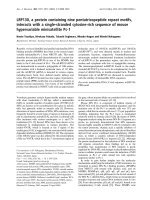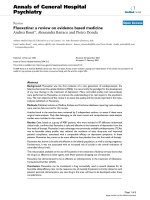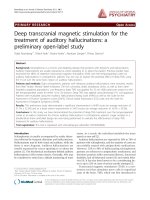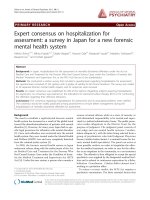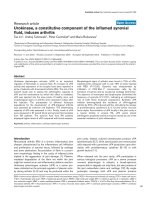Báo cáo y học: " Pruritus: a useful sign for predicting the haemodynamic changes that occur following administration of vancomycin" ppsx
Bạn đang xem bản rút gọn của tài liệu. Xem và tải ngay bản đầy đủ của tài liệu tại đây (50.31 KB, 6 trang )
Critical Care June 2002 Vol 6 No 3 Bertolissi et al.
Research
Pruritus: a useful sign for predicting the haemodynamic changes
that occur following administration of vancomycin
Massimo Bertolissi
1
, Flavio Bassi
2
, Roberta Cecotti
3
, Carlo Capelli
4
and Francesco Giordano
5
1
Senior Staff Consultant, Second Department of Anesthesia and Intensive Care Medicine, Azienda Ospedaliera, S. Maria della Misericordia, Udine, Italy
2
Consultant, Second Department of Anesthesia and Intensive Care Medicine, Azienda Ospedaliera, S. Maria della Misericordia, Udine, Italy
3
Resident, Second Department of Anesthesia and Intensive Care Medicine, Azienda Ospedaliera, S. Maria della Misericordia, Udine, Italy
4
Professor, Institute of Human Physiology, Udine University, Italy
5
Director, Second Department of Anesthesia and Intensive Care Medicine, Azienda Ospedaliera, S. Maria della Misericordia, Udine, Italy
Correspondence: Massimo Bertolissi,
Introduction
Vancomycin is among the most effective antibiotics for treat-
ment of methicillin-resistant Staphylococcus aureus infec-
tions [1–4], and it is widely used prophylactically in cardiac
surgery [5–7]. Among the adverse effects of vancomycin
(apart from nephrotoxicity and ototoxicity), anaphylactoid
reactions may occur, which manifest clinically as cutaneous
rash, pruritus (‘red man’ syndrome), hypotension and bron-
cospasm [4,8,9]. These reactions are caused by histamine
release, and are not mediated by an immunological mecha-
nism [10,11].
In our cardiosurgical center vancomycin is administered pro-
phylactically before induction of anaesthesia in all patients
undergoing open-heart surgery, and in some such patients we
CI = cardiac index; PaO
2
= arterial oxygen tension; PVRI = pulmonary vascular resistance index; Qsp/Qt = shunt fraction; SVI = stroke volume
index; SVRI = systemic vascular resistance index.
Abstract
Introduction The aim of this study was to investigate the haemodynamic changes that follow the
appearance of pruritus during vancomycin administration.
Methods We studied 50 patients scheduled for coronary artery bypass surgery, and we compared
data from patients who exhibited pruritus with those from patients who did not. After the monitoring
devices had been positioned, vancomycin (15 mg/kg) was continuously infused at a constant rate over
30 min, before induction of anaesthesia. Haemodynamic profiles were recorded before vancomycin
infusion (time point 1); at 15 (time point 2) and 30 min (time point 3) after the beginning of vancomycin
infusion; and 15 min after vancomycin infusion had been stopped (time point 4). At each time arterial
and mixed venous blood samples were drawn to calculate the shunt fraction (Qsp/Qt).
Results In patients who exhibited pruritus (group A, n = 17) at time point 3 versus time point 1,
systemic vascular resistance index (SVRI) and arterial oxygen tension (PaO
2
) decreased significantly;
cardiac index (CI), stroke volume index (SVI) and Qsp/Qt increased significantly; and mean systemic
pressure and heart rate were stable. Those changes were observed only in patients not treated with a
β-blocker before surgery, whereas no change occurred in patients treated with the drug. In the patients
who were free from pruritus (group B, n = 28), we did not observe any significant change.
Conclusion The appearance of pruritus during vancomycin administration indicates that SVRI is
declining, thus exposing the patient to risk for hypotension. Therapy with a β-blocker appears to confer
protection against this hemodynamic reaction.
Keywords haemodynamics, shunt fraction, pruritus, respiratory gases exchange, vancomycin
Received: 25 March 2002
Accepted: 3 April 2002
Published: 25 April 2002
Critical Care 2002, 6:234-239
© 2002 Bertolissi et al., licensee BioMed Central Ltd
(Print ISSN 1364-8535; Online ISSN 1466-609X)
Available online />have observed the occurrence of pruritus, localized or general-
ized, during infusion of the antibiotic. We therefore conducted
the present study to investigate the haemodynamic behaviour
that follows the occurrence of pruritus, and to compare it with
that observed in patients who are free from this clinical sign.
Patients and methods
We studied 50 patients undergoing elective coronary artery
bypass surgery, following approval from the local ethics com-
mittee and once written informed consent had been obtained
from each patient. Admission criteria to the study were as
follows: stable preoperative haemodynamic conditions, no
intravenous cardiovascular therapy, no preoperative diuretic
therapy, sinus rhythm, no history of anaphylactic reactions,
and normal hepatic and renal function.
Preoperative therapy was continued until the morning of the
operation. Premedication consisted of morphine (0.1 mg/kg)
and scopolamine (0.005 mg/kg), administered intramuscu-
larly 1 hour before the patient entered the operating room.
After the monitoring devices had been positioned (electrocar-
diograph leads DII–V5 for ST-segment analysis; radial artery
cannula and pulmonary artery catheter [Arrow AH 050050-H,
7.5 F; Arrow International, Inc., Reading, PA, USA] transcuta-
neous oxygen saturation probe), vancomycin (15 mg/kg) was
administered at a constant rate by a syringe pump (DPS Fre-
senius; Grenoble, France) over 30 min.
A complete haemodynamic profile was taken for each patient at
the following time points: before the administration of vanco-
mycin (time point 1); at 15 (time point 2) and 30 min (time point
3) after the beginning of vancomycin infusion; and 15 min after
vancomycin infusion had been stopped (time point 4). Apart
from collection of haemodynamic data, at each time point two
blood samples were drawn (one from the radial artery cannula
and another from the distal port of the pulmonary artery
catheter) in order to measure arterial and mixed venous blood
parameters that are necessary for calculation of Qsp/Qt (i.e.
haemoglobin concentration, and oxygen tension and saturation).
Each haemodynamic profile consisted of parameters measured
directly (i.e. heart rate, systemic and pulmonary pressures, pul-
monary capillary wedge pressure, central venous pressure and
cardiac output) and those that were calculated (i.e. SVRI, pul-
monary vascular resistance index [PVRI], CI and SVI).
The pulmonary shunt fraction (Qsp/Qt) was calculated using
the following equation [12]:
CcO
2
– CaO
2
Qsp/Qt = (1)
CcO
2
– CvO
2
Where CcO
2
is the pulmonary capillary oxygen content,
CaO
2
is the arterial oxygen content, and CvO
2
is the mixed
venous oxygen content.
Analysis of the blood samples was performed by the same
operator, using a blood gas system (model 288; Ciba Corning,
Medfield, MA, USA) located just outside the operating room.
During the study all patients breathed room air, and crystalloid
was continuously infused at a rate of 2 ml/kg per hour, which
was increased if necessary to offset a moderate reduction in
systemic arterial pressure. If mean blood pressure decreased
by more than 20%, then more fluids and/or boluses of
ephedrine were infused, vancomycin infusion was temporarily
discontinued and the patient was excluded from the study.
The patients were divided into two groups: group A, including
patients who exhibited pruritus during vancomycin infusion;
and group B, including those patients who did not exhibit pru-
ritis. Each group was then divided into two subgroups on the
basis of preoperative therapy with a β-blocker; subgroups A1
and B1 were treated with a β-blocker, whereas subgroups
A2 and B2 were not.
The results are expressed as mean ± standard deviation.
Data were analysed using Student’s t-test and analysis of
variance with Bonferroni correction. P < 0.05 was considered
statistically significant.
Results
Group A included 17 patients (subgroup A1, n = 11; and
subgroup A2, n = 6) and group B included 28 patients (sub-
group B1, n = 17; and subgroup B2, n = 11). Five patients
were excluded from the study because of reduction in mean
blood pressure by more than 20% (n = 2), angina (n =1,
treated with the intravenous administration of nitroglycerin)
and intolerable pruritus (n = 2).
Data on the general characteristics of the patients are provided
in Table 1. There were no significant differences between the
Table 1
General characteristics of the patients studied
Parameter Group A Group B
Age (years) 63 ± 7 64 ± 8
Weight (kg) 77 ± 9 77 ± 12
LVEF (%) 55 ± 12 50 ± 13
Preoperative therapy (n)
β-blocker 11 17
Trinitroglycerin 16 26
Calcium channel blocker 4 7
Digoxin 0 2
ACE inhibitors 4 10
No significant difference was observed between the groups in terms of
age, weight, left ventricular ejection fraction (LVEF), or preoperative
therapy. ACE, angiotensin-converting enzyme.
Critical Care June 2002 Vol 6 No 3 Bertolissi et al.
groups in terms of age, weight, preoperative left ventricular
ejection fraction, preoperative therapy, or basal haemodynamic
and respiratory data (time point 1, Table 1). Table 2 lists the
mean amounts of fluids infused during the study.
At time point 3 as compared with time point 1, patients in
group A exhibited a significant reduction (P < 0.05) in SVRI
and PVRI, and a significant increase (P < 0.05) in CI and SVI
(Table 3). Heart rate and mean systemic arterial pressure
exhibited a slight but not significant decrease, whereas the
other haemodynamic parameters remained stable. At time
Table 2
Mean amounts of fluids infused during the study
Groups and subgroups Intravenous fluids (ml)
Group A 330 ± 133
Subgroup A1 280 ± 67
Subgroup A2 421 ± 180
Group B 226 ± 40
Subgroup B1 230 ± 43
Subgroup B2 220 ± 38
See text for definitions of groups and subgroups.
Table 3
Haemodynamic and respiratory gas modifications at the four time points of the study: whole study population
Time point
Parameter Group 1 2 3 4
HR (beats/min) A 60 ± 11 59 ± 11 60 ± 9 58 ± 8
B 65 ± 11 63 ± 12 64 ± 12 62 ± 11
MSP (mmHg) A 85 ± 17 81 ± 21 81 ± 18 84 ± 17
B 88 ± 18 88 ± 20 88 ± 21 92 ± 20
SVRI (dynes·s/cm
5
per m
2
) A 2808 ± 577 2533 ± 507 2351 ± 602* 2559 ± 539
B 2610 ± 942 2720 ± 1057 2544 ± 879 2821 ± 780
CI (l/min per m
2
) A 2.34 ± 0.5 2.42 ± 0.5 2.64 ± 0.5* 2.5 ± 0.4
B 2.67 ± 0.6 2.56 ± 0.5 2.74 ± 0.6 2.58 ± 0.5
SVI (ml/beat per m
2
) A 39 ± 8 41 ± 8 44 ± 7* 43 ± 9
B 42 ± 11 41 ± 9 43 ± 10 42 ± 10
MPP (mmHg) A 15 ± 4 15 ± 5 15 ± 4 16 ± 5
B 15 ± 4 16 ± 5 15 ± 6 16 ± 7
PCWP (mmHg) A 8 ± 3 9 ± 4 8 ± 3 8 ± 4
B 7 ± 3 7 ± 3 6 ± 4 7 ± 4
PVRI (dynes·s/cm
5
per m
2
) A 233 ± 103 224 ± 67 215 ± 66* 242 ± 80
B 240 ± 127 285 ± 204 264 ± 168 277 ± 167
CVP (mmHg) A 3 ± 2 4 ± 2 3 ± 1 4 ± 2
B 2 ± 1 2 ± 1 2 ± 1 2 ± 1
PaO
2
(mmHg) A 80.3 ± 10 74.6 ± 12 71.6 ± 9* 76.1 ± 12
B 75.6 ± 12 72 ± 13 71.8 ± 12 71.3 ± 11
SaO
2
(%) A 95.8 ± 1.5 94.7 ± 2 94.2 ± 2* 95 ± 2.4
B 94.9 ± 2 94.1 ± 2.4 94.3 ± 2 94.3 ± 2
PaCO
2
(mmHg) A 38 ± 3 37 ± 3 38 ± 3 38 ± 3
B 37 ± 3 37 ± 5 37 ± 5 37 ± 4
Qsp/Qt (%) A 12 ± 5 17 ± 6 18 ± 6* 14 ± 8
B 15 ± 6 17 ± 8 17 ± 7 17 ± 6
*P < 0.05, versus time point 1 within each group. See text for definitions of groups, subgroups and time points. CI, cardiac index; CVP, central
venous pressure; HR, heart rate; MPP, mean pulmonary pressure; MSP, mean systemic pressure; PaCO
2
, arterial carbon dioxide tension; PaO
2
,
arterial oxygen tension; PCWP, pulmonary capillary wedge pressure; PVRI, pulmonary vascular resistance index; Qsp/Qt, shunt fraction; SaO
2
,
arterial oxygen saturation; SVI, stroke volume index; SVRI, systemic vascular resistance index.
points 2 and 4 there were no significant changes in haemody-
namic parameters as compared with time point 1.
Patients in group B and in subgroups A1, B1, and B2 did not
show any significant haemodynamic change throughout the
study (Tables 4 and 5). However, patients of subgroup A2
showed a significant increase (P < 0.05) in heart rate (versus
time point 2), CI and SVI, and a significant decrease
(P < 0.05) in SVRI and PVRI at time point 3 as compared
with time point 1 (Table 4).
PaO
2
and arterial carbon dioxide tension, arterial oxygen satu-
ration and Qsp/Qt did not change significantly in patients of
subgroups A1, B1, B2, and group B throughout the study
(Tables 3–5). However, PaO
2
and arterial oxygen saturation
showed a significant reduction, and Qsp/Qt a significant
increase at time point 3 as compared with time point 1 in
patients of group A and subgroup A2 (Tables 3 and 4).
In the majority of cases studied pruritus was mild or moder-
ate, and localized on the scalp, face, neck or upper torso. In a
few cases it was severe and spread all over the body surface.
In four cases pruritis was accompanied by a cutaneous rash,
and no other clinical sign was observed.
Discussion
The development of pruritus, an important symptom of hista-
mine release, is relatively frequent with vancomycin adminis-
tration [2–4]. It generally appears alone, but sometimes it is
associated with headache; flushing; erythematous rash over
the face, neck and upper torso (the so-called ‘red man’ syn-
drome); hypotension; and broncospasm [4,13–15]. One of
the most important factors that impact on the incidence of
these adverse reactions is the vancomycin infusion rate. For
example, Renz and coworkers [11] infused 1 g vancomycin
over 10 min to patients scheduled for elective prosthetic joint
replacement, and found that 90% of patients had rash and
pruritus, and 50% had significant hypotension. Also, Valero
and coworkers [7] administered 1 g vancomycin over 30 min
to cardiac surgical patients and observed hypotension in
25% of cases. For this reason, the international literature rec-
ommends that vancomycin be infused over a period of 60 min
Available online />Table 4
Haemodynamic and respiratory gas modifications at the four time points of the study: subgroups A1 and A2
Time point
Parameter Group 1 2 3 4
HR (beats/min) A1 58 ± 9 60 ± 10 57 ± 9 55 ± 7
A2 65 ± 13 59 ± 13 66 ± 7
†
65 ± 6
MSP (mmHg) A1 89 ± 18 89 ± 19 86 ± 19 88 ± 18
A2 76 ± 11 67 ± 16 72 ± 12 78 ± 13
SVRI (dynes·s/cm
5
per m
2
) A1 2741 ± 635 2578 ± 540 2501 ± 605 2564 ± 447
A2 2946 ± 471 2457 ± 482 2080 ± 544*
†‡
2554 ± 728
CI (l/min per m
2
) A1 2.53 ± 0.5 2.61 ± 0.5 2.61 ± 0.5 2.57 ± 0.4
A2 2.00 ± 0.3 2.07 ± 0.5 2.70 ± 0.5*
†
2.38 ± 0.4
SVI (ml/beat per m
2
) A1 44 ± 5 44 ± 6 46 ± 6 47 ± 7
A2 32 ± 9 36 ± 9 41 ± 7* 37 ± 9
PVRI (dynes·s/cm
5
per m
2
) A1 208 ± 104 207 ± 76 194 ± 77 226 ± 84
A2 278 ± 92 256 ± 35 224 ± 36*
‡
274 ± 65
PaO
2
(mmHg) A1 83 ± 9 78.2 ± 10 75.3 ± 10 78.9 ± 12
A2 76.9 ± 13 68.4 ± 13 65.8 ± 7* 71.4 ± 11
SaO
2
(%) A1 96.2 ± 1 95.3 ± 2 95 ± 2 95.4 ± 2
A2 95.1 ± 2 93.6 ± 2 93 ± 2* 94 ± 3
Qsp/Qt (%) A1 12 ± 4 15 ± 6 15 ± 5 13 ± 6
A2 14 ± 6 20 ± 6 20 ± 6* 17 ± 8
*P < 0.05, versus time point 1 within each group;
†
P < 0.05, versus time point 2 within each group;
‡
P < 0.05 versus time 4 within each group.
See text for definitions of groups, subgroups and time points. CI, cardiac index; HR, heart rate; MSP, mean systemic pressure; PaO
2
, arterial
oxygen tension; PVRI, pulmonary vascular resistance index; Qsp/Qt, shunt fraction; SaO
2
, arterial oxygen saturation; SVI, stroke volume index;
SVRI, systemic vascular resistance index.
in order to prevent these side effects, and hypotension in par-
ticular, which in some cases manifests as life-threatening
shock [6,8,9,16].
The present study was conducted to investigate the haemody-
namic changes that occur following the appearance of pruritus.
We therefore opted to administer vancomycin over a period of
30 min in order to encourage appearance of the sign, as the
coronary patients were adequately monitored and the anaes-
thetist was therefore in the optimal conditions to detect and
treat any change in cardiorespiratory function at an early stage.
Our analysis of haemodynamic profiles shows that, in those
patients who exhibited pruritus (group A), systemic vascular
resistance fell significantly 30 min after initiation of vanco-
mycin administration. This effect was transient, disappearing
15 min later. The reduction in systemic vascular resistance
was not accompanied by a significant decrease in systemic
arterial pressure, and because heart rate was unchanged, the
increase in stroke volume offset the peripheral vasodilatation
induced by the antibiotic. On the contrary, in patients free
from pruritus (group B), those haemodynamic changes were
not observed and all of the parameters considered remained
stable throughout the study. In group A the normovolaemic
condition of the patients and the fluids infused during the
study undoubtedly contributed to haemodynamic compensa-
tion. However, it may be supposed that if vancomycin is
administered to an hypovolaemic patient then this compensa-
tion cannot be as effective and hypotension may occur. We
were unable to confirm this for two reasons: first, hypo-
volaemia was among the exclusion criteria; and second, we
considered exposure of a coronary patient to the additional
stress of relative hypovolaemia to be harmful. However, con-
sidering the different amounts of crystalloid infused in each
group, we can indirectly deduce that fluid compensation con-
tributed to the maintenance of stable values for mean systemic
pressure when systemic vascular resistance decreased.
The stability of heart rate in face of a reduction in systemic
vascular resistance in group A patients renders possible an
influence of preoperative β-blocker therapy on haemodynamic
compensation. Confirmation of this is indicated by the differ-
ent trends of heart rate in the group A patients who were
treated with a β-blocker as compared with those who were
Critical Care June 2002 Vol 6 No 3 Bertolissi et al.
Table 5
Haemodynamic and respiratory gas modifications at the four time points of the study: subgroups B1 and B2
Time point
Parameter Group 1 2 3 4
HR (beats/min) B1 62 ± 10 60 ± 12 62 ± 10 59 ± 9
B2 70 ± 10 67 ± 11 66 ± 12 66 ± 11
MSP (mmHg) B1 90 ± 18 91 ± 20 91 ± 21 95 ± 20
B2 84 ± 18 83 ± 18 84 ± 20 86 ± 21
SVRI (dynes·s/cm
5
per m
2
) B1 2511 ± 562 2623 ± 519 2392 ± 380 2607 ± 415
B2 2884 ± 1200 3021 ± 1600 2842 ± 1253 2980 ± 1160
CI (l/min per m
2
) B1 2.80 ± 0.5 2.69 ± 0.4 2.90 ± 0.5 2.70 ± 0.4
B2 2.46 ± 0.6 2.36 ± 0.6 2.49 ± 0.7 2.40 ± 0.6
SVI (ml/beat per m
2
) B1 46 ± 10 46 ± 8 47 ± 7 46 ± 8
B2 36 ± 8 36 ± 9 38 ± 11 37 ± 10
PVRI (dynes·s/cm
5
per m
2
) B1 218 ± 64 227 ± 76 253 ± 77 242 ± 96
B2 296 ± 183 365 ± 228 320 ± 197 332 ± 207
PaO
2
(mmHg) B1 75.3 ± 12 74.4 ± 13 73 ± 13 73 ± 12
B2 73.6 ± 13 72 ± 13 73.4 ± 10 70 ± 9
SaO
2
(%) B1 95 ± 2 94.5 ± 2 94.4 ± 2 94.7 ± 2
B2 94.5 ± 2 94 ± 2 94.6 ± 2 94 ± 2
Qsp/Qt (%) B1 16 ± 7 17 ± 8 17 ± 7 16 ± 7
B2 16 ± 5 17 ± 6 16 ± 6 17 ± 4
No significant difference was observed within the two groups. See text for definitions of groups, subgroups and time points. CI, cardiac index; HR,
heart rate; MSP, mean systemic pressure; PaO
2
, arterial oxygen tension; PVRI, pulmonary vascular resistance index; Qsp/Qt, shunt fraction; SaO
2
,
arterial oxygen saturation; SVI, stroke volume index; SVRI, systemic vascular resistance index.
not. The stability of heart rate in subgroup A1 and the signifi-
cant increase in subgroup A2 represents proof that β-blocker
therapy limited that compensatory mechanism to peripheral
vasodilatation. Surprisingly, assessment of other haemody-
namic parameters (SVRI, CI, SVI) revealed a significant
change only in those patients who were affected by pruritus
and not treated with a β-blocker, as though treatment had
antagonized all of the cardiovascular effects triggered by the
release of histamine during vancomycin administration.
However, because the number of the patients studied was
small, these findings require further investigation and confir-
mation in larger studies.
The significant increase in Qsp/Qt and decrease in PaO
2
in
the patients affected by pruritus can be interpreted as the
effect of an imbalance in the ventilation/perfusion ratio,
induced by the vasodilating action of vancomycin on the pul-
monary circulation, as supported by the significant reduction
in pulmonary vascular resistance at time point 3. Also, the
respiratory changes were significant only in patients of group
A who were not treated with a β-blocker, whereas preopera-
tive use of the drug eliminated any significant respiratory
change. The degree of reduction in PaO
2
was moderate and
had no important impact on arterial haemostasis in the
patients studied, who showed however normal preoperative
respiratory function.
A limitation in the calculation of Qsp/Qt was that the patients
were breathing room air during the study. In such conditions,
apart from changes in the Qsp/Qt, the decrease in PaO
2
may
be caused by effects of maldistribution in the ventilation/per-
fusion ratio. For this reason we must consider the Qsp/Qt not
as an absolute value but as a relative one, but we can never-
theless attribute meaning to changes in this parameter [12].
On the basis of the results obtained, we conclude that occur-
rence of pruritus during vancomycin administration must be
considered an alarm bell that indicates the presence of
peripheral vasodilatation. It can help the physician to identify
at an early stage those patients who are at risk for hypoten-
sion (e.g. hypovolaemic patient) and to compensate for hypo-
volaemia before continuing administration of vancomycin.
This benefit is useful not so much in intensive care units
(where patients are continuously and adequately monitored)
as in medical and surgical departments overall, where moni-
toring of arterial pressure is not continuous and nurse care is
not as strict as in the intensive care unit.
Finally, the lack of haemodynamic and respiratory changes in
the patients affected by pruritus and treated with a β-blocker
before surgery makes it probable that these agents can
confer protection against the anaphylactoid reactions that are
mediated by release of histamine.
Competing interests
None declared.
References
1. Fekety R: Vancomycin and teicoplanin. In Principles and Prac-
tice of Infectious Disease. Edited by Mandell GL, Bennett JE,
Dolin R. New York: Churchill Livingstone; 1995:346-354.
2. Wilhelm MP, Estes L: Symposium on antimicrobal agents: van-
comycin. Mayo Clin Proc 1999, 74:928-935.
3. Wilhelm MP: Vancomycin. Mayo Clin Proc 1991, 66:1165-1170.
4. Leader WG, Chandler MH, Castiglia M: Pharmacokinetic opti-
misation of vancomycin therapy. Clin Pharmacokinet 1995, 28:
327-342.
5. Romanelli VA, Howie MB, Myerowitz PD, Zvara DA, Rezaei A,
Jackman DL, Sinclair DS, McSweeney TD: Intraoperative and
postoperative effects of vancomycin administration in cardiac
surgery patients: a prospective, double-blind, randomised
trial. Crit Care Med 1993, 21:1124-1131.
6. Rosemberg JM, Wahr JA, Smith KA: Effects of vancomycin infu-
sion on cardiac function in patients scheduled for cardiac
operations. J Thorac Cardiovasc Surg 1995, 109:561-564.
7. Valero R, Gomar C, Fita G, Gonzalez M, Pacheco M, Mulet J,
Nalda MA: Adverse reactions to vancomycin prophylaxis in
cardiac surgery. J Cardiothorac Vasc Anesth 1991, 5:574-576.
8. Southorn PA, Plevak DJ, Wright AJ, Wilson WR: Adverse effects
of vancomycin administered in the perioperative period. Mayo
Clin Proc 1986, 61:721-724.
9. von Kaenel WE, Bloomfield EL, Amaranath L, Wilde AA: Van-
comycin does not enhance hypotension under anesthesia.
Anesth Analg 1993, 76:809-811.
10. Renz CL, Laroche D, Thurn JD, Finn HA, Lynch JP, Thisted R,
Moss J: Tryptase levels are not increased during vancomycin-
induced anaphylactoid reactions. Anesthesiology 1998, 89:
620-625.
11. Renz CL, Thurn JD, Finn HA, Lynch JP, Moss J: Oral antihista-
mines reduce the side effects from rapid vancomycin infu-
sion. Anesth Analg 1998, 87:681-685.
12. Nunn JF: Distribution of pulmonary ventilation and perfusion.
In Applied Respiratory Physiology, 5th ed. Edited by Lumb AB,
Nunn JF. Cambridge: Butterworth-Heinemann; 1993:163-199.
13. Wallace MR, Mascola JR, Oldfield EC: Red man syndrome: inci-
dence, etiology and prophylaxis. J Infect Dis 1991, 164:1180-
1185.
14. Polk RE: Red man syndrome. Ann Pharmacother 1998; 32:840.
15. Sahai J, Healy DP, Shelton MJ, Miller JS, Ruberg SJ, Polk R: Com-
parison of vancomycin and teicoplanin induced histamine
release and ‘red man syndrome’. Antimicrob Agents Chemother
1990, 34:765-769.
16. Dajee H, Laks H, Miller J, Oren R: Profound hypotension from
rapid vancomycin administration during cardiac operation. J
Thorac Cardiovasc Surg 1984, 87:145-146.
Available online />Key messages
• Pruritus, which may occur during vancomycin
administration, can be considered an alarm bell,
indicating the presence of peripheral vasodilatation.
• The physician encountering pruritus during vancomycin
administration must correct the condition of
hypovolaemia before continuing vancomycin infusion.
• Pruritus is also associated with a slight but significant
reduction in PaO
2
and increase in Qsp/Qt.
• Patients affected by pruritus during vancomycin
infusion but who were treated with a β-blocker before
surgery did not exhibit any significant haemodynamic
or respiratory change.




